The first. A story without which Tesla would not exist
2016 year. Heat. Nizhny Novgorod. In the parking lot of the retro rally "Peking - Paris" a crowd crowded around, a guy stood near the huge La France and mumbled something, directing the smartphone to every detail. I listened, he noticed my attention and asked in surprise: “Is it really here ?!” Indeed, our city was a rally stage with a length of more than 14 thousand km, and at that time cars from 1907 to 1972. passed almost two thirds of the way. Many of them were not just retro cars - they were models on which something appeared for the first time, which were the basis of the entire automotive industry. They were the ones without which there would have been no heated debate on Habré about Tesla or BMW. They were the first.
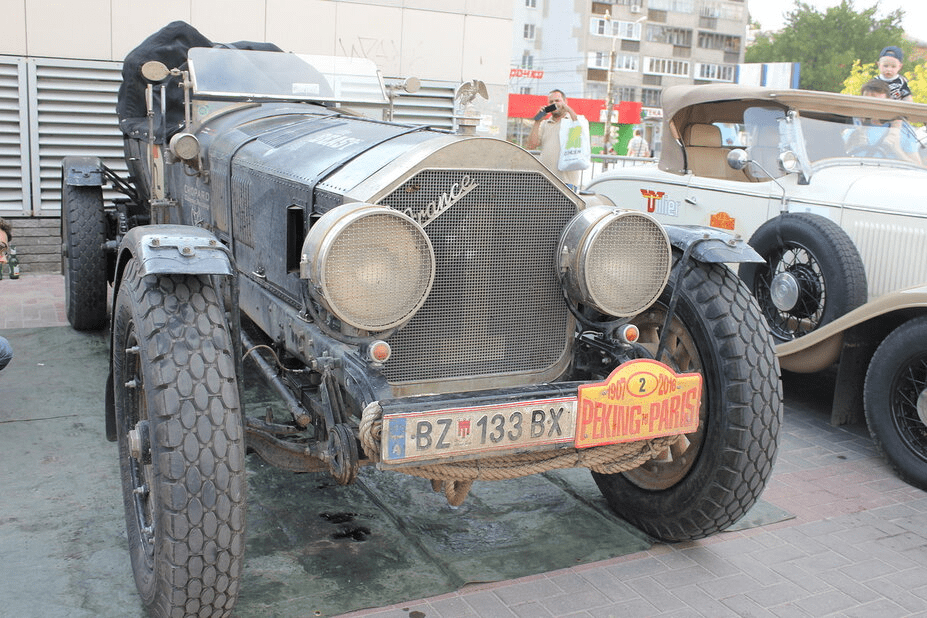
Chain drive, wooden spokes wheels, authentic interior - La France. Yes she could
The first attempts to create something similar to an internal combustion engine existed in the 18th century, when scientists were puzzled as to how to take and convert the energy of a fuel into mechanical energy. The first, perhaps, were the brothers Niepce (France), who invented pyreolofor - the engine of coal dust. However, their innovation was not recognized, and the engine remained on the drawings.
Then there were successful and not very experiments of Etienne Lenoir - a two-stroke engine with a carburetor and spark ignition from an outside source on coal gas, then a Siegfried Marcus single-cylinder carburetor engine (first worked from oil combustion and installed on a “car” squeezing 10 miles per hour) , in 1873, George Brighton's huge engine literally appeared ... But Nicholas Otto made a breakthrough.
')
The four-stroke internal combustion engine was first built by Nicholas Otto in 1878, and this invention affected the entire automotive industry. The merit of the creation of the first car with an internal combustion engine belongs to Karl Benz and dates back to 1885. Benz's first single-cylinder engine had less than one horsepower.
However, the first production car with a diesel engine appeared much later - in 1936, it became the Mercedes-Benz 260D.
However, as often happened in the history of science, the right to invent a crew without horses with an internal combustion engine was also challenged by other automakers, for example, Siegfried Marcus in 1883 and Gottlieb Daimler in 1886. Daimler designed the prototype of a modern gas engine with vertical cylinders. and a carburetor. It was a compact model, whose main task was to provide an acceptable high speed of movement of the car.
So, the engine was invented, but cars can not climb a relatively steep hill, they do not have enough "strength". The fact. that ICEs are capable of developing the necessary operating power in a small rev range, and how then can the torque be changed without being limited by the engine's capabilities? There was a need for a mechanism that would transmit the rotational moment of the engine to the wheels of the car. This mechanism was invented by Louis Reno ... or not?
Not really. It all started with the invention of Karl Benz. In 1890, Karl's wife, Berta, along with the son of the inventor, secretly from her husband and father set off on a road 80 km long to show the world her husband’s car and prove that it was not a “devilish car.” It was a terrible, unbearably difficult path: leather brakes were wearing out, and I had to collect naphtha, a means for removing stains, from pharmacies and shops. 0.8 HP the engine lacked power and Bert and his son were constantly forced to push the car. Following the trip, Mr. Benz sat down at the blueprints.
The recent movie Mersedes about Bertha’s exploit. A journey that changed everything.
The first version was primitive: two pulleys of different diameters on a driving axle, which was connected to the motor shaft with a belt. Everything. This construction worked on the basis of simple physics, changing the torque on the drive wheels. If a pulley located on the motor shaft rotated a pulley of a larger diameter axis, the torque increased and the car started to move. If the small pulley rotated, the angular speed of the wheels increased and the engine effort became less. A little later, the belt was replaced by a chain, the pulleys were replaced by asterisks (remember the car at the beginning of the post? Is it just that).

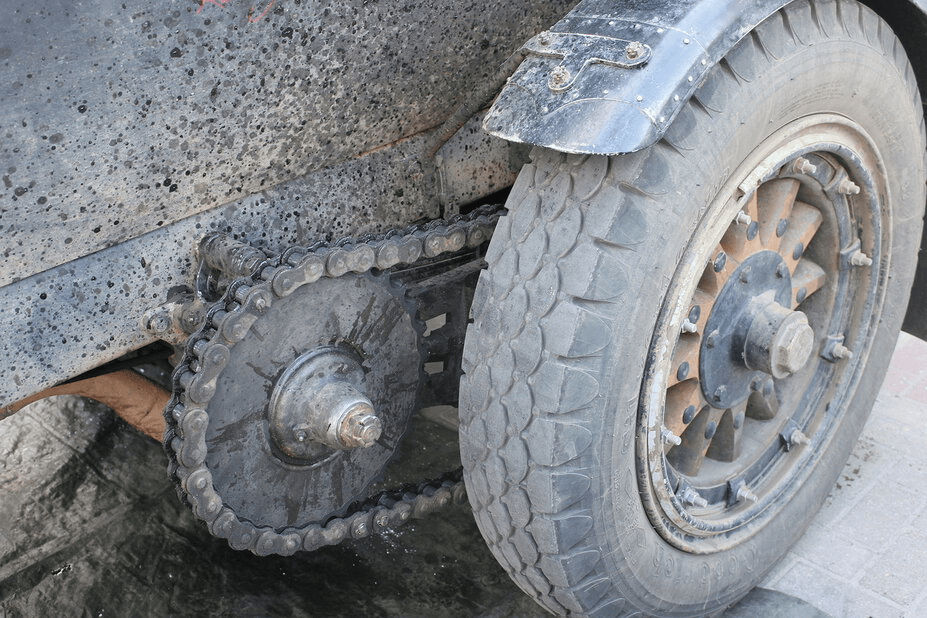
La france
And what about Louis Renault? Error in the facts? Not.
A more modern gearbox was invented in 1898 and was first used in the Renault Voiturette (Renault Avtomobilchik). On December 24, 1898, Louis Reno defiantly drove his car through one of the coolest streets in Paris - this would have been impossible without a gearbox. But front-wheel drive first appeared only in 1929 on the car Cord L29, although it reached mass production in the post-war years.
So what then invented Louis Renault? In fact, the driveshaft. The Voiturette Type A series model had an engine power of 1.75 hp. and was equipped with the world's first gearbox with three "front" speeds and one rear. The direct drive with the driveshaft, invented by the founder of Reno, is used in rear-wheel drive cars to this day.
This is, of course, a manual gearbox, but the automatic gearbox appeared in the United States in 1939 in Oldsmobile Custom 8 Cruiser cars.
The first cars were equipped with tillers - control levers, there was no question of any round steering wheel. Management was obvious, but inefficient at high speed: the driver pulled the lever to the right or left and the car turned in the direction indicated. Actually, it is the thirst for speed (well, at that time of speed) gave impetus to the introduction of a round rudder. With the advent of cars by the end of the XIX century, the first races began to appear, in which tiller control turned into a driver's nightmare.

Daimler car with ICE 1889 with tillers
In 1894, Alfred Vacheron installed a round steering wheel on his Panhard 4hp and made a worthy appearance in the Paris-Rouen race. By 1898, the entire Panhard was equipped with a steering wheel. His example was followed by other automakers. The first steering wheels (yes, the first ones — first up to the 30s, and then up to the 50s of the 20th century) had a hard unregulated steering pad, which led to terrible injuries to drivers, sometimes even with not very serious accidents.
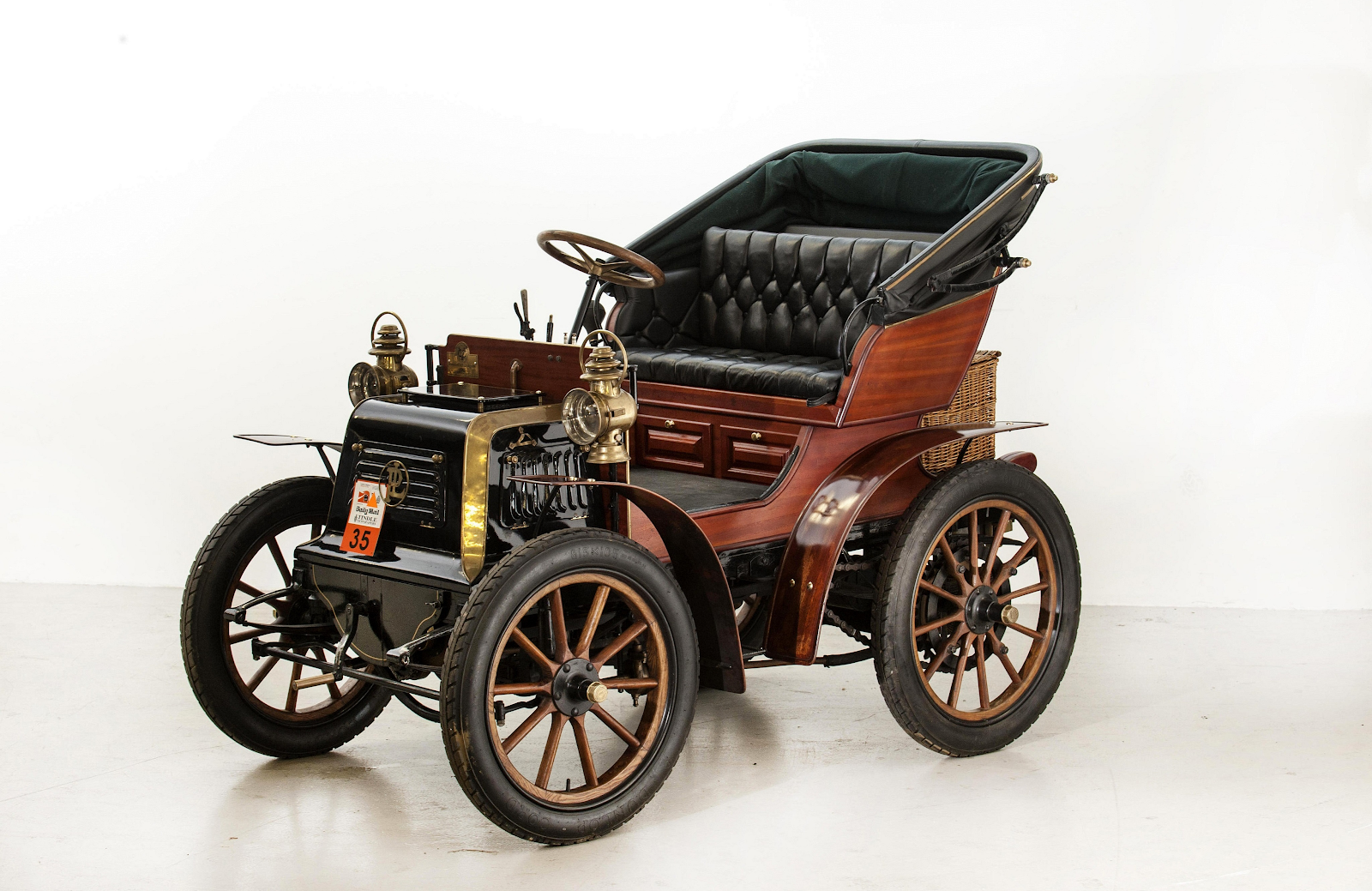
Panhard with steering wheel
By the way, in 1910 the first electric horn appeared.
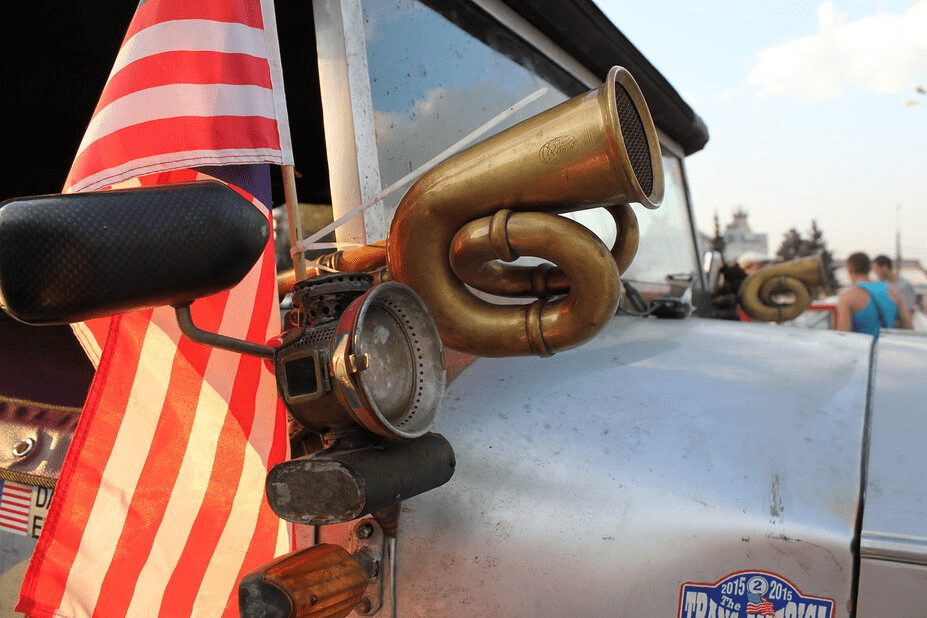
And so was the horn of one of the 2016 Rolls-Royce rally.
Guess who invented the three-point seat belts? If you are passionate about cars, you probably guessed the word "security" - of course, Volvo. They first appeared in the Volvo PV 544 model. Until then, of course, they existed even more than a hundred years, but were not reliable and effective - the usual fastener with two points.
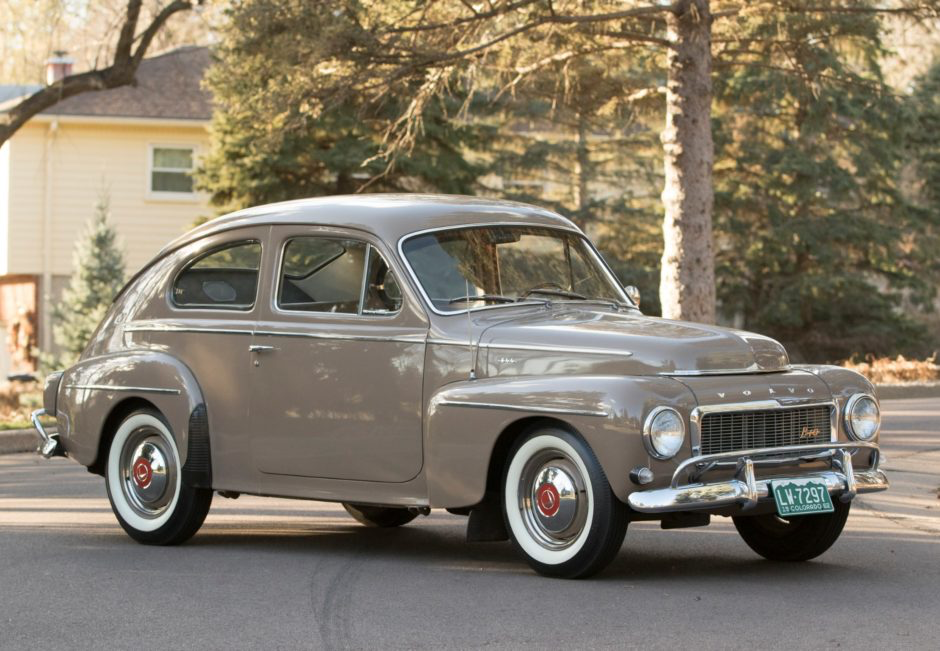
Volvo PV 544
Among the first cars have their own superheroes, which turned out to be the "pioneers" of several devices at once. One of these was the 1912 Cadillac Model 30 Self Starter: the model presented to the public had a starter, an ignition and the first headlights with a tungsten filament (and not a loose coal). As for the starter, he replaced the crooked starter (the same handle that the first engines had turned on. However, this handle is still relevant for some cars, for example, for some UAZ vehicles). By the way, it was the invention of the starter that partly threw away the existence of electric vehicles for many years ago: the use of the internal combustion engine became simple and the motivation for the development of electric motors disappeared, and internal combustion engines were to be developed.

Cadillac Model 30 Self Starter
Stop what other electric motors?
The first serial electric car is considered the 2009 Mitsubishi i-MiEV ... Stop! We are not interested in 2009, we are interested in 1828, when Hungarian physicist Anosh Istvan Yedlik invented the electric carriage. Tesla's ancestors did not end there: in 1834, the blacksmith Thomas Davenport created his electric version of the car, followed by the Dutchman Sibrand Stratingh and his assistant Christopher Becker, who equipped their invention with a rechargeable battery. But the most advanced and more or less “tenacious” car turned out in 1890 with William Morrison - he developed a speed of up to 22 km / h. These were not one-off experiments - by the beginning of the 20th century, 30% of all cars in the United States were electric.
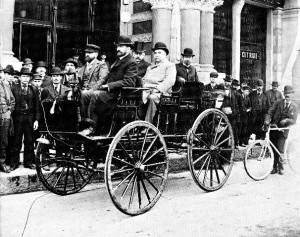
Electric car of William Morrison, 1890
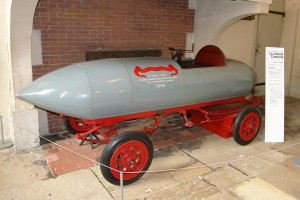
Electric car La Jamais Contente 1899, reached a speed of 100 km / h. Pay attention to ergonomics and for those times over futuristic design.
We already mentioned the starter, which probably became the killer of the electric car, but in fact there was a more obvious killer - the Ford T car. Henry Ford used the assembly line for car assembly, thereby significantly reducing the cost of the vehicle. And then it was about ingenious commerce: the great millionaire refused the margin and earned on the goods turnover, making the first people's car in history. The Ford T turned out to be three times cheaper than an electric car - the winner of the competitive race was determined.

Ford T - "killer" electric cars
Cars of the past continue to haunt the thoughts of both engineers and fans - imagine, they are ready to prepare their car and pay a contribution of $ 65,000 to start from Beijing, drive through the steppes of Mongolia and Kazakhstan, cross the Altai, drive through Russia and get to Paris in a rally where everyone is already a winner. This year we are waiting for the rally “Beijing - Paris” in Nizhny Novgorod on June 24 and are preparing for a professional and warm meeting. Because nothing can be compared with these cars, thanks to which the story took place.
PS On the official site of the rally, you can see the route and find out which cities will have intermediate stages - do not miss in your city!

Chain drive, wooden spokes wheels, authentic interior - La France. Yes she could
Internal combustion engine
The first attempts to create something similar to an internal combustion engine existed in the 18th century, when scientists were puzzled as to how to take and convert the energy of a fuel into mechanical energy. The first, perhaps, were the brothers Niepce (France), who invented pyreolofor - the engine of coal dust. However, their innovation was not recognized, and the engine remained on the drawings.
Then there were successful and not very experiments of Etienne Lenoir - a two-stroke engine with a carburetor and spark ignition from an outside source on coal gas, then a Siegfried Marcus single-cylinder carburetor engine (first worked from oil combustion and installed on a “car” squeezing 10 miles per hour) , in 1873, George Brighton's huge engine literally appeared ... But Nicholas Otto made a breakthrough.
')
The four-stroke internal combustion engine was first built by Nicholas Otto in 1878, and this invention affected the entire automotive industry. The merit of the creation of the first car with an internal combustion engine belongs to Karl Benz and dates back to 1885. Benz's first single-cylinder engine had less than one horsepower.
However, the first production car with a diesel engine appeared much later - in 1936, it became the Mercedes-Benz 260D.
However, as often happened in the history of science, the right to invent a crew without horses with an internal combustion engine was also challenged by other automakers, for example, Siegfried Marcus in 1883 and Gottlieb Daimler in 1886. Daimler designed the prototype of a modern gas engine with vertical cylinders. and a carburetor. It was a compact model, whose main task was to provide an acceptable high speed of movement of the car.
Transmission
So, the engine was invented, but cars can not climb a relatively steep hill, they do not have enough "strength". The fact. that ICEs are capable of developing the necessary operating power in a small rev range, and how then can the torque be changed without being limited by the engine's capabilities? There was a need for a mechanism that would transmit the rotational moment of the engine to the wheels of the car. This mechanism was invented by Louis Reno ... or not?
Not really. It all started with the invention of Karl Benz. In 1890, Karl's wife, Berta, along with the son of the inventor, secretly from her husband and father set off on a road 80 km long to show the world her husband’s car and prove that it was not a “devilish car.” It was a terrible, unbearably difficult path: leather brakes were wearing out, and I had to collect naphtha, a means for removing stains, from pharmacies and shops. 0.8 HP the engine lacked power and Bert and his son were constantly forced to push the car. Following the trip, Mr. Benz sat down at the blueprints.
The recent movie Mersedes about Bertha’s exploit. A journey that changed everything.
The first version was primitive: two pulleys of different diameters on a driving axle, which was connected to the motor shaft with a belt. Everything. This construction worked on the basis of simple physics, changing the torque on the drive wheels. If a pulley located on the motor shaft rotated a pulley of a larger diameter axis, the torque increased and the car started to move. If the small pulley rotated, the angular speed of the wheels increased and the engine effort became less. A little later, the belt was replaced by a chain, the pulleys were replaced by asterisks (remember the car at the beginning of the post? Is it just that).


La france
And what about Louis Renault? Error in the facts? Not.
A more modern gearbox was invented in 1898 and was first used in the Renault Voiturette (Renault Avtomobilchik). On December 24, 1898, Louis Reno defiantly drove his car through one of the coolest streets in Paris - this would have been impossible without a gearbox. But front-wheel drive first appeared only in 1929 on the car Cord L29, although it reached mass production in the post-war years.
So what then invented Louis Renault? In fact, the driveshaft. The Voiturette Type A series model had an engine power of 1.75 hp. and was equipped with the world's first gearbox with three "front" speeds and one rear. The direct drive with the driveshaft, invented by the founder of Reno, is used in rear-wheel drive cars to this day.
This is, of course, a manual gearbox, but the automatic gearbox appeared in the United States in 1939 in Oldsmobile Custom 8 Cruiser cars.
Right steering
The first cars were equipped with tillers - control levers, there was no question of any round steering wheel. Management was obvious, but inefficient at high speed: the driver pulled the lever to the right or left and the car turned in the direction indicated. Actually, it is the thirst for speed (well, at that time of speed) gave impetus to the introduction of a round rudder. With the advent of cars by the end of the XIX century, the first races began to appear, in which tiller control turned into a driver's nightmare.

Daimler car with ICE 1889 with tillers
In 1894, Alfred Vacheron installed a round steering wheel on his Panhard 4hp and made a worthy appearance in the Paris-Rouen race. By 1898, the entire Panhard was equipped with a steering wheel. His example was followed by other automakers. The first steering wheels (yes, the first ones — first up to the 30s, and then up to the 50s of the 20th century) had a hard unregulated steering pad, which led to terrible injuries to drivers, sometimes even with not very serious accidents.

Panhard with steering wheel
By the way, in 1910 the first electric horn appeared.

And so was the horn of one of the 2016 Rolls-Royce rally.
There are no trifles
Guess who invented the three-point seat belts? If you are passionate about cars, you probably guessed the word "security" - of course, Volvo. They first appeared in the Volvo PV 544 model. Until then, of course, they existed even more than a hundred years, but were not reliable and effective - the usual fastener with two points.

Volvo PV 544
Inventions in one line
- Airbags appeared late - in 1972. For the first time they were installed on the Ford Taunus 20M P7B and Oldsmobile Toronado, but gained wide popularity in more than a decade.
- Air conditioning appeared in 1939 on the Packard Twelve Sedan. It was very expensive and extremely uncomfortable to use.
- The first audio system appeared in 1930, these were Motorola radio installations, in 1932 the famous Blaupunkt appeared on the German Studebaker.
- But the janitors invented a woman, an American, Mary Anderson, who invented and patented a mechanical drive for the brushes with which drivers cleaned the windshields. Electric wipers invented Charlotte Bridgewood 14 years later, in 1917. But the massive "hanging" janitors merit the company Bosch.
- Turning in the form in which we know them, appeared on the Buick Roadmaster in 1939, they replaced the mechanical arrows and uncomfortable flashlights.
- The first power steering appeared on the luxurious Chrysler Crown Imperial in 1951, replacing the pneumatic system and the power of human muscles. Three years later, power steering reached Europe - in French Citroen DS 19. By the way, it was the Citroen DS 19 that became the first owner of disc brakes. Anyway, it was a surprisingly advanced in its time car.
- Drum brakes on all wheels first appeared on the Lancia Lambda in 1922.
Among the first cars have their own superheroes, which turned out to be the "pioneers" of several devices at once. One of these was the 1912 Cadillac Model 30 Self Starter: the model presented to the public had a starter, an ignition and the first headlights with a tungsten filament (and not a loose coal). As for the starter, he replaced the crooked starter (the same handle that the first engines had turned on. However, this handle is still relevant for some cars, for example, for some UAZ vehicles). By the way, it was the invention of the starter that partly threw away the existence of electric vehicles for many years ago: the use of the internal combustion engine became simple and the motivation for the development of electric motors disappeared, and internal combustion engines were to be developed.

Cadillac Model 30 Self Starter
Stop what other electric motors?
Two centuries before Tesla
The first serial electric car is considered the 2009 Mitsubishi i-MiEV ... Stop! We are not interested in 2009, we are interested in 1828, when Hungarian physicist Anosh Istvan Yedlik invented the electric carriage. Tesla's ancestors did not end there: in 1834, the blacksmith Thomas Davenport created his electric version of the car, followed by the Dutchman Sibrand Stratingh and his assistant Christopher Becker, who equipped their invention with a rechargeable battery. But the most advanced and more or less “tenacious” car turned out in 1890 with William Morrison - he developed a speed of up to 22 km / h. These were not one-off experiments - by the beginning of the 20th century, 30% of all cars in the United States were electric.

Electric car of William Morrison, 1890

Electric car La Jamais Contente 1899, reached a speed of 100 km / h. Pay attention to ergonomics and for those times over futuristic design.
We already mentioned the starter, which probably became the killer of the electric car, but in fact there was a more obvious killer - the Ford T car. Henry Ford used the assembly line for car assembly, thereby significantly reducing the cost of the vehicle. And then it was about ingenious commerce: the great millionaire refused the margin and earned on the goods turnover, making the first people's car in history. The Ford T turned out to be three times cheaper than an electric car - the winner of the competitive race was determined.

Ford T - "killer" electric cars
Cars of the past continue to haunt the thoughts of both engineers and fans - imagine, they are ready to prepare their car and pay a contribution of $ 65,000 to start from Beijing, drive through the steppes of Mongolia and Kazakhstan, cross the Altai, drive through Russia and get to Paris in a rally where everyone is already a winner. This year we are waiting for the rally “Beijing - Paris” in Nizhny Novgorod on June 24 and are preparing for a professional and warm meeting. Because nothing can be compared with these cars, thanks to which the story took place.
If you are from Nizhny Novgorod, then the time and place is here. Of course, visiting the check point and parking is completely free.

PS On the official site of the rally, you can see the route and find out which cities will have intermediate stages - do not miss in your city!
Source: https://habr.com/ru/post/456810/
All Articles